 It is very common for younger generations to question their future endeavors. Many college graduates and adults, well into their late twenties, are still finding their place in the workforce, what they want to spend forty to fifty hours a week doing. There are those who even go to college for something totally the opposite of what they end up pursuing, only a few years into their futures. As for myself, I am happy to say I have somewhat of an idea of where I can see my future going, but only so far. It's hard to tell people you don't know what you want to do when your currently enrolled in a career specialized college. But, to be honest I don't know. I am still trying to find my place in the food industry; what interests me the most about cooking every day. What’s it about plating food with tweezers and small serving spoons that intrigues me; or how excited I get to style food on a plate, stage it with props, and snap shots for you to see? Perhaps, I am on an inspiring journey, searching for my culinary identity.
It is very common for younger generations to question their future endeavors. Many college graduates and adults, well into their late twenties, are still finding their place in the workforce, what they want to spend forty to fifty hours a week doing. There are those who even go to college for something totally the opposite of what they end up pursuing, only a few years into their futures. As for myself, I am happy to say I have somewhat of an idea of where I can see my future going, but only so far. It's hard to tell people you don't know what you want to do when your currently enrolled in a career specialized college. But, to be honest I don't know. I am still trying to find my place in the food industry; what interests me the most about cooking every day. What’s it about plating food with tweezers and small serving spoons that intrigues me; or how excited I get to style food on a plate, stage it with props, and snap shots for you to see? Perhaps, I am on an inspiring journey, searching for my culinary identity.
Recently I read an article online about a person who was seeking their culinary identity, and it opened up my mind to something I never really considered before. I have always been curious to what exactly my cooking style was. I realized that, I am one of hundreds of culinary students, here at the CIA, finding their culinary identity. Exactly, that’s just the word to describe it! Culinary Identity is about finding your style through geography, culture, tradition, education, and trends in the food industry. Similarly, this concept can be used for any person finding their self in the world, what they have passion for, or their identity in the work force. But, as for chefs out there seeking their culinary identity, what is it that speaks to their style the most? Farm to Table American or classic French cuisine? How about presentation styles; are they into presenting food to an audience with more of a homey rustic approach or is it fine dining quality? Do they like small, intimate restaurants, that turn a table every 2-3 hours, serving guests tasting menus with miniscule portions, or do they like high volume production, catering to wedding parties of over two hundred people in one sitting? On spectrum of food media, perspective chefs may consider writing cook books, working for a food magazine testing recipes, or on Food Network in front of a camera crew. The options are substantial, and that may be why as chefs, we find ourselves in a frenzy over what we want to do. We often hope that miraculously we are told what we are going to like for the rest of our lives, so we no longer have to wait and wonder. But, in this life the only way you are going to find your passion is through trial and error, working, staging, experiencing, and be educated. “There are times to stay put, and what you want will come to you, and there are times to go out into the world and find such a thing for yourself”, a quote from Lemony Snicket, Horseradish.
Aspiring chefs may find it difficult to settle on what they see oneself doing in life. Most of the time a life of a chef revolves around a swinging kitchen door, other times they are traveling in box trucks unloading prepped food for a wedding on the beach, and sometimes they share their experiences and love of food in cookbooks and on television shows. With the countless options there are, you as a chef will find what you are seeking, and what exactly your palate for life is!
 Polka dots, pearls, and pot de creme is one way to keep a woman in her fifties feeling glamorous on her birthday! After a long weekend trip away for business, my mother returned home in time for a small "happy birthday" sing along before she went off to bed. Earlier in the week I asked if she either wanted her famous sour cream fudge cake or pot de creme to enjoy when she arrived home. And if I don't know my mother, she's always down for anything decadent with chocolate. But since I got no answer on either choice, I went with pot de creme in which I decided to top with whipped cream and rhubarb sugar. I admire the individual cupcake cups because they create consistent portion sizes and make way for easy cleanup. And when I clean up that just means my mom has to "clean up" after me, so I made it a bit easier on both our parts (haha)!
Polka dots, pearls, and pot de creme is one way to keep a woman in her fifties feeling glamorous on her birthday! After a long weekend trip away for business, my mother returned home in time for a small "happy birthday" sing along before she went off to bed. Earlier in the week I asked if she either wanted her famous sour cream fudge cake or pot de creme to enjoy when she arrived home. And if I don't know my mother, she's always down for anything decadent with chocolate. But since I got no answer on either choice, I went with pot de creme in which I decided to top with whipped cream and rhubarb sugar. I admire the individual cupcake cups because they create consistent portion sizes and make way for easy cleanup. And when I clean up that just means my mom has to "clean up" after me, so I made it a bit easier on both our parts (haha)!




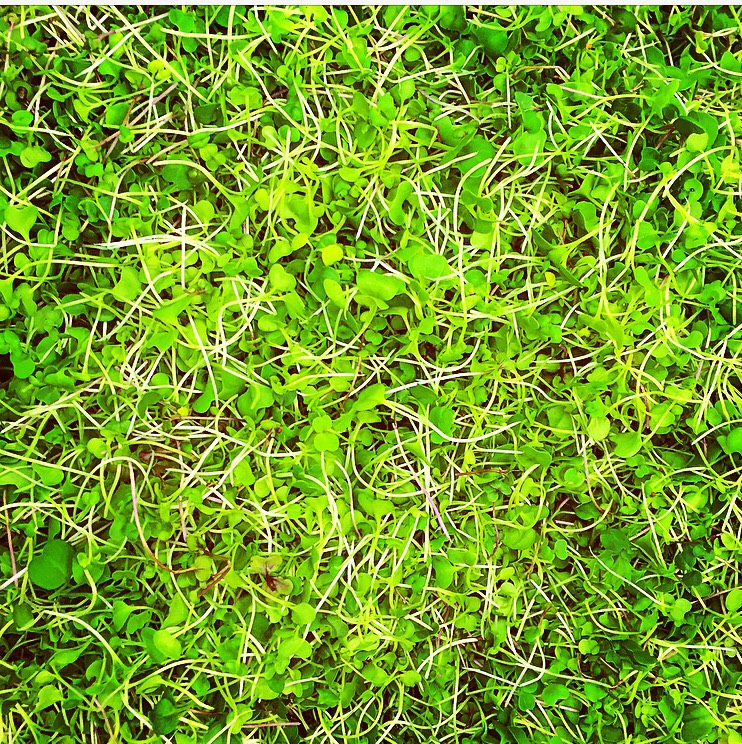 Sprout, micro, baby, mature; four vital stages in producing beautiful vegetables, fruits, and herbs. In recent years, scientists have found that micro greens are quite the super food, providing antioxidants and nutrients. In 2012, after studies from the United States Department of Agriculture were conducted, news was released stating that micro greens have increasingly higher nutritional value than that of the full grown plant. Apparently one of the best vitamins to gain in eating micros is vitamin C. For every 100 grams of micro greens, there are 20 milligrams of vitamin C. And, not to mention it’s more than twice the amount of vitamin C that would be found in tomatoes, our beloved summer fruit. Cabbage is surprisingly weighing in at 147 milligrams of vitamin C for every 100 grams of micro cabbage. And to compare that number of micros to 100 grams of full grown cabbage, there is 90 milligrams more vitamin C in the micros. Research also proved that the beta carotene (which reduces risk of eye disease) found in carrots is more nutrient dense in micro greens with 12 milligrams per 100 grams. Daikon radish micros are known for high levels of vitamin E; just a sprinkle over a salad will help you get the vitamins you need. Lastly, vitamin K produced during photosynthesis is abundant in amaranth greens, a vitamin that helps us maintain strong bones.
Sprout, micro, baby, mature; four vital stages in producing beautiful vegetables, fruits, and herbs. In recent years, scientists have found that micro greens are quite the super food, providing antioxidants and nutrients. In 2012, after studies from the United States Department of Agriculture were conducted, news was released stating that micro greens have increasingly higher nutritional value than that of the full grown plant. Apparently one of the best vitamins to gain in eating micros is vitamin C. For every 100 grams of micro greens, there are 20 milligrams of vitamin C. And, not to mention it’s more than twice the amount of vitamin C that would be found in tomatoes, our beloved summer fruit. Cabbage is surprisingly weighing in at 147 milligrams of vitamin C for every 100 grams of micro cabbage. And to compare that number of micros to 100 grams of full grown cabbage, there is 90 milligrams more vitamin C in the micros. Research also proved that the beta carotene (which reduces risk of eye disease) found in carrots is more nutrient dense in micro greens with 12 milligrams per 100 grams. Daikon radish micros are known for high levels of vitamin E; just a sprinkle over a salad will help you get the vitamins you need. Lastly, vitamin K produced during photosynthesis is abundant in amaranth greens, a vitamin that helps us maintain strong bones.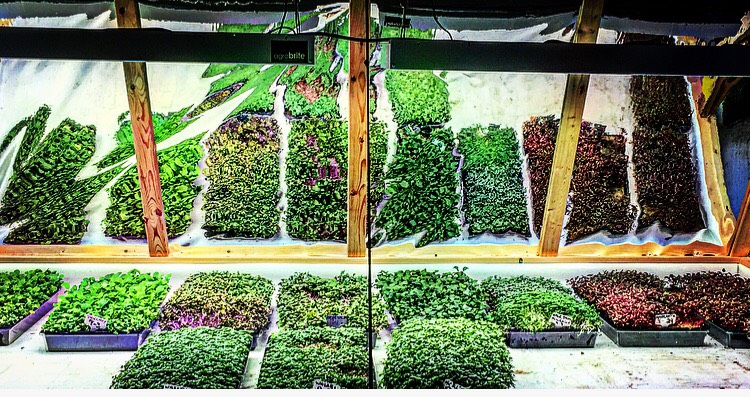
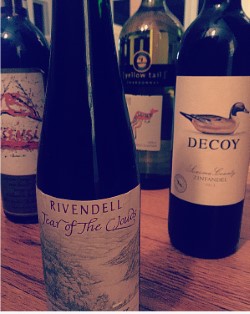 Weather is the first factor to consider when growing grapes for wine. Currently France is experiencing a climate change effecting the areas well known for wine such as Bordeaux, Languedoc, and Champagne. California is also dealing with the current drought. Soil type and structure, grape type, climate, and history of the surrounding area in which grapes come from is what makes each one individually different from any other grape. Just like fruits and vegetables, climate change is vital to grape production, and will affect the soil in which the grape grows. These attributes are otherwise known as terroir; something that acquires flavor and ambiance through soil, ground, locality, or the place it comes from. How exactly will the weather patterns of France and California effect our future wine varieties.
Weather is the first factor to consider when growing grapes for wine. Currently France is experiencing a climate change effecting the areas well known for wine such as Bordeaux, Languedoc, and Champagne. California is also dealing with the current drought. Soil type and structure, grape type, climate, and history of the surrounding area in which grapes come from is what makes each one individually different from any other grape. Just like fruits and vegetables, climate change is vital to grape production, and will affect the soil in which the grape grows. These attributes are otherwise known as terroir; something that acquires flavor and ambiance through soil, ground, locality, or the place it comes from. How exactly will the weather patterns of France and California effect our future wine varieties.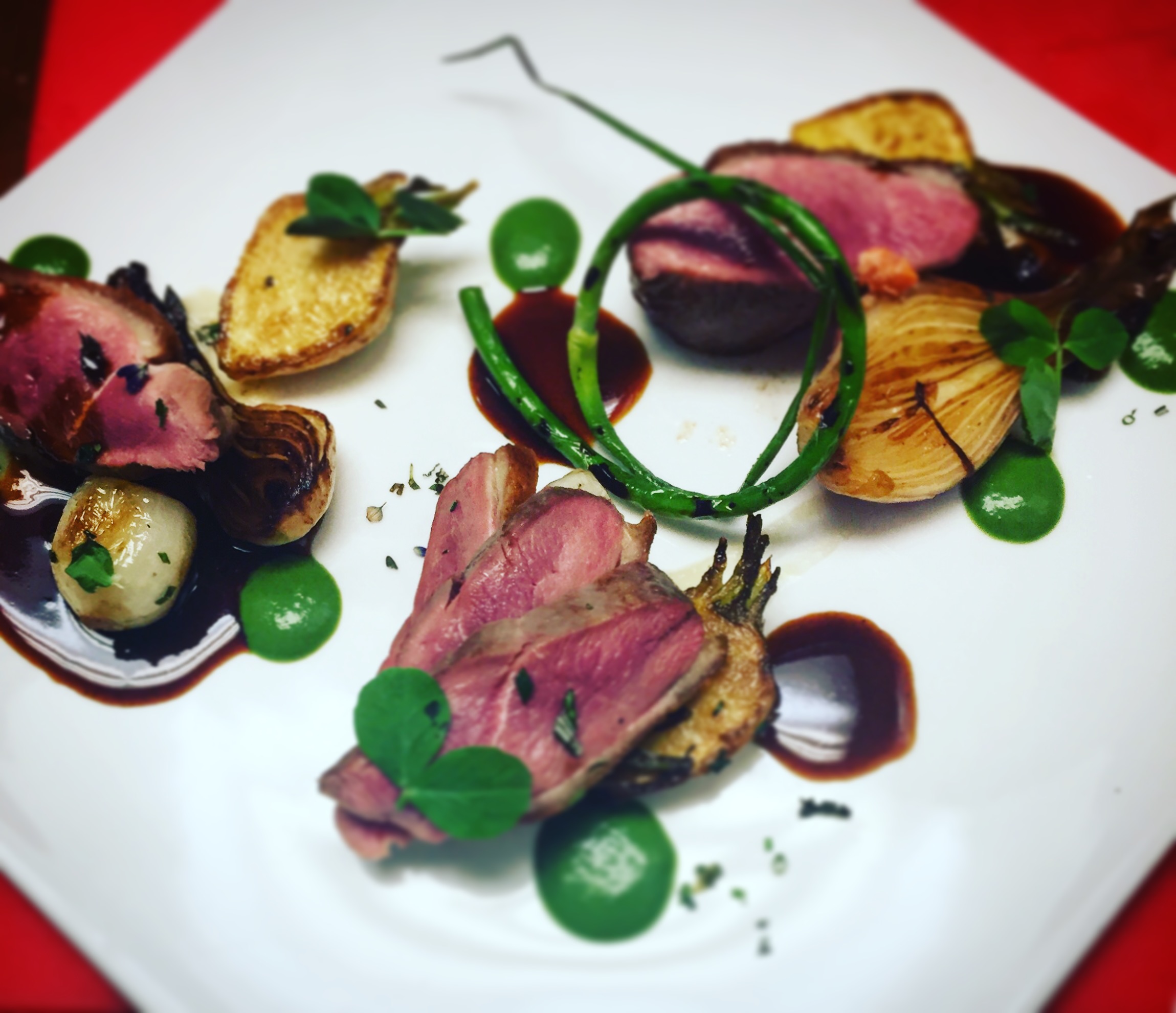 Looks like a whip, tastes like garlic, and grows where the wild things live. Garlic scapes are a member of the allium family along with shallots, chives, rakkyo, and onions. Its more common to see the scape during the summer season. Fine dining restaurants love to play around with this ingredient, making it a seasonal guest on their sophisticated summer menus. I myself have had some experience cooking and plating it, as seen in the photograph above. At my current place of work, we use the garlic scape in two ways on our duck entree.First, I blanch the scapes and blend with salt and chicken stock to make the vibrant green puree, which we dot around the plate. The other way we use the scape is by grilling it and placing it whole on the plate, which acts as the final garnish.
Looks like a whip, tastes like garlic, and grows where the wild things live. Garlic scapes are a member of the allium family along with shallots, chives, rakkyo, and onions. Its more common to see the scape during the summer season. Fine dining restaurants love to play around with this ingredient, making it a seasonal guest on their sophisticated summer menus. I myself have had some experience cooking and plating it, as seen in the photograph above. At my current place of work, we use the garlic scape in two ways on our duck entree.First, I blanch the scapes and blend with salt and chicken stock to make the vibrant green puree, which we dot around the plate. The other way we use the scape is by grilling it and placing it whole on the plate, which acts as the final garnish.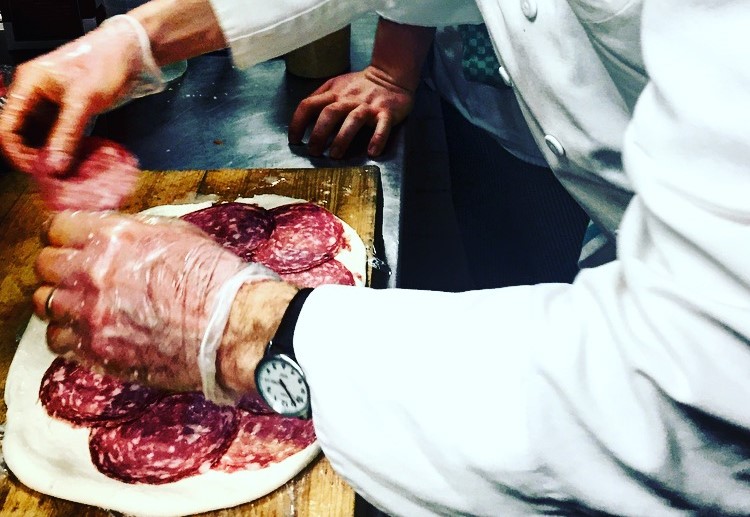 Perline, Chilegine,Bocconcini, Ovoline, and Rotundine as beautifully written, are the names of Italy's mozzarella shapes. Perline is the smallest, working its way up to the larger, Rotundine. And interestingly enough, Bocca means mouth, with bocconcini symbolizing, the perfect ball of mozzarella to fit inside ones mouth. Whether we eat fresh mozzarella in a Caprese salad, or melt it into Pasta alla Norma, there are the many different sizes to choose from. To make mozzarella, the chef must gather milk (preferably whole), citric acid, and rennet (helps make the cheese sturdy); the ingredients are heated between 90- 105 degrees throughout the whole process. Once the milk mixture curdles forming a custard like consistency, it is nearly done. At this point you may start kneading the curd to form mozzarella and shape into its various sizes. Some may use the whole ball and stretch it out for a roulade (see above); this method, known as pasta filata, means to stretch the curd. And the term Mozara, comes from a fisherman's term meaning to pinch the head off a fish. When making mozzarella, one must pinch the curd into the desired sizes and toss into an ice water bath. Buratta is a softer form of mozzarella, made in the same way as the delectable curd, with the addition of a few things. After forming the shape of the mozzarella, the chef takes a mixture of heavy cream and leftover mozzarella shards, and pours it inside the middle of the mozzarella.The ball is tied with a leek leave, securing its shape, and later removed once it has cooled. It can be served at room temp with EVOO, balsamic reduction/pesto, and crostini. The preparation of buratta came about, as a way to use the leftover pieces of mozzarella in the whey.
Perline, Chilegine,Bocconcini, Ovoline, and Rotundine as beautifully written, are the names of Italy's mozzarella shapes. Perline is the smallest, working its way up to the larger, Rotundine. And interestingly enough, Bocca means mouth, with bocconcini symbolizing, the perfect ball of mozzarella to fit inside ones mouth. Whether we eat fresh mozzarella in a Caprese salad, or melt it into Pasta alla Norma, there are the many different sizes to choose from. To make mozzarella, the chef must gather milk (preferably whole), citric acid, and rennet (helps make the cheese sturdy); the ingredients are heated between 90- 105 degrees throughout the whole process. Once the milk mixture curdles forming a custard like consistency, it is nearly done. At this point you may start kneading the curd to form mozzarella and shape into its various sizes. Some may use the whole ball and stretch it out for a roulade (see above); this method, known as pasta filata, means to stretch the curd. And the term Mozara, comes from a fisherman's term meaning to pinch the head off a fish. When making mozzarella, one must pinch the curd into the desired sizes and toss into an ice water bath. Buratta is a softer form of mozzarella, made in the same way as the delectable curd, with the addition of a few things. After forming the shape of the mozzarella, the chef takes a mixture of heavy cream and leftover mozzarella shards, and pours it inside the middle of the mozzarella.The ball is tied with a leek leave, securing its shape, and later removed once it has cooled. It can be served at room temp with EVOO, balsamic reduction/pesto, and crostini. The preparation of buratta came about, as a way to use the leftover pieces of mozzarella in the whey.



